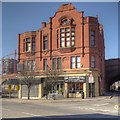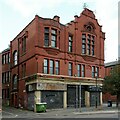1
Cross Street
View looking up Cross Street in Salford.
Image: © Peter McDermott
Taken: 1 Oct 2017
0.01 miles
2
Sacred Trinity Parish School
This building on Blackfriars Road was the former Sacred Trinity Parish School.
Image: © Sue Adair
Taken: 25 Jul 2009
0.03 miles
3
Manchester Tennis & Racquet Courts
Manchester Tennis & Racquets Courts is an uninspiring building on Blackfriars Road, opened in 1880 and designed by architect GT Redmayne. Defying its outer appearance, the interior boasts a number of historical features including a real tennis court and skittle alley.
Image: © Sue Adair
Taken: 25 Jul 2009
0.03 miles
4
Manchester Exchange station - engineering train
Manchester Victoria station used to be connected to the erstwhile Exchange station by the longest platform in the country. At the far west end, D5054 brings an engineering train from the west through the station. Definitely 1968, probably around Easter.
Image: © Robin Webster
Taken: Unknown
0.04 miles
5
Sacred Trinity Church
Sacred Trinity church was originally built as a chapel-of-ease to serve the growing population of Salford in 1635. It is Salford's oldest church and is a grade II listed building with many original features. Most of the current building dates from 1752 but it was restored in 1877-74 and adapted for more flexible use in the 1980’s. Painted by LS Lowry in 1925 it is one of the only views in his paintings that remains unchanged. William Webb Ellis was
Christened here (famed for inventing the game of Rugby in 1823).
Image: © Sue Adair
Taken: 25 Jul 2009
0.05 miles
6
Caxton Hall, Salford
The once impressive Caxton Hall, rendered somewhat less impressive by the modern shop frontages
References say that it was built in 1907 for the Typographical Society of Manchester although the front of the building clearly carries the date “1904” (
Image]). It was named after William Caxton http://en.wikipedia.org/wiki/William_Caxton , inventor of the printing press. The building was hired out to socialists and trade union activists for most of its life and was an important venue for the labour movement in Salford and Manchester.
http://www.visitsalford.info/documents/chapelstreettrail.pdf Chapel Street Heritage Trail
http://manchesterhistory.net/manchester/outside/SALFORD/caxtonhall.html Manchester History Net
Image: © David Dixon
Taken: 11 Mar 2014
0.05 miles
7
Chapel Street, Caxton Hall
The once impressive Caxton Hall, rendered somewhat less impressive by the modern shop frontages
References say that it was built in 1907 for the Typographical Society of Manchester although the front of the building clearly carries the date “1904” (
Image]). It was named after William Caxton http://en.wikipedia.org/wiki/William_Caxton , inventor of the printing press. The building was hired out to socialists and trade union activists for most of its life and was an important venue for the labour movement in Salford and Manchester.
http://www.visitsalford.info/documents/chapelstreettrail.pdf Chapel Street Heritage Trail
http://manchesterhistory.net/manchester/outside/SALFORD/caxtonhall.html Manchester History Net
Image: © David Dixon
Taken: 11 Mar 2014
0.05 miles
8
Caxton Hall
A close-up look at the front of Caxton Hall (see
Image] and
Image] for wider views) show that it carries the date 1904 although the first reference cited below says that it was built in 1907 for the Typographical Society of Manchester. It was named after William Caxton http://en.wikipedia.org/wiki/William_Caxton , inventor of the printing press.
The building was hired out to socialists and trade union activists for most of its life and was an important venue for the labour movement in Salford and Manchester.
http://www.visitsalford.info/documents/chapelstreettrail.pdf Chapel Street Heritage Trail
http://manchesterhistory.net/manchester/outside/SALFORD/caxtonhall.html Manchester History Net
Image: © David Dixon
Taken: 11 Mar 2014
0.05 miles
9
Blackfriars Road, Salford
Looking along Blackfriars Road (A6041), towards Blakes' Vauxhall dealership, from Cross Street.
Image: © David Dixon
Taken: Unknown
0.05 miles
10
Caxton Hall, Chapel Street, Salford
Built in 1904 for the Manchester Typographical Society, which was very active in the Trades Union. It comprised meeting rooms and offices with lettable retail spaces at ground level. The name commemorates William Caxton who introduced printing to Britain in the 15th century. An attractive building in red brick and terracotta, but not listed.
Image: © Alan Murray-Rust
Taken: 23 Aug 2024
0.06 miles











